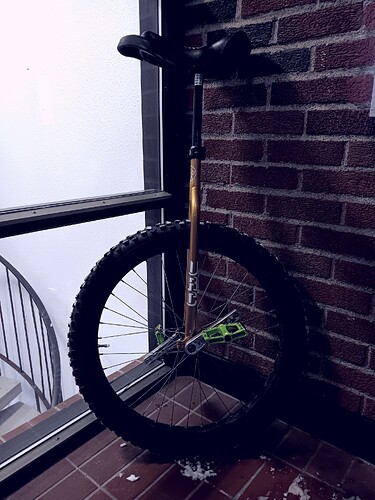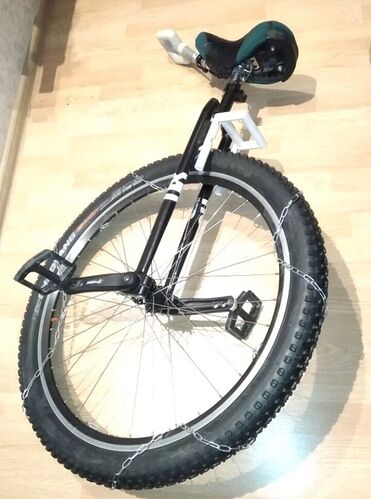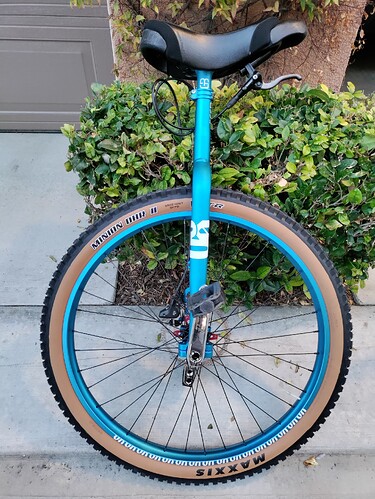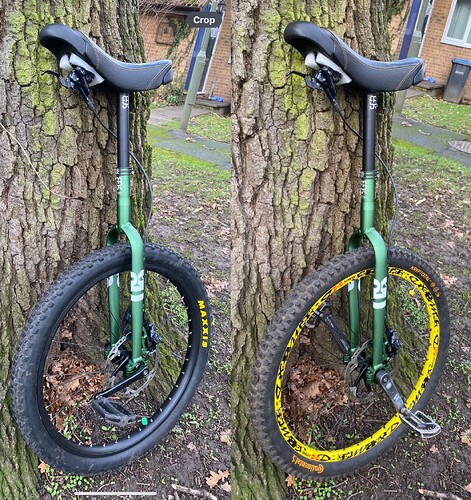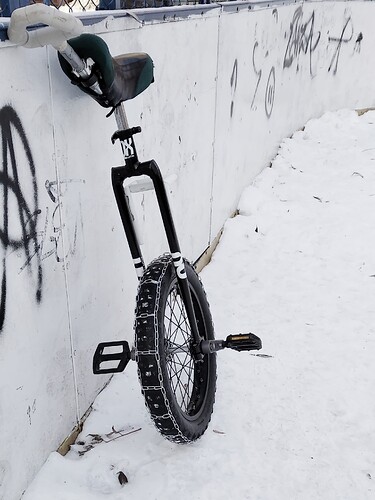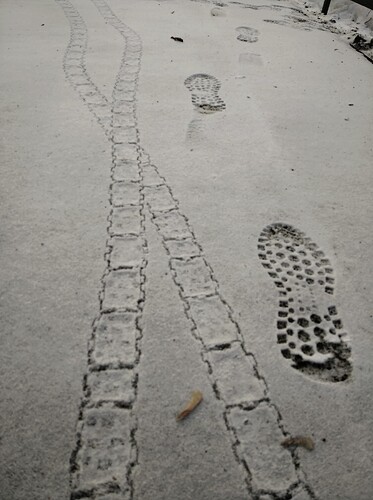I did already go out for the quickest evening test ride in the snow already, despite it being really late here. I mean, I had to right? ![]()
I begin experiments with winter chain. Thanks to climate change fighters, the weater has become too frosty. Have anyone experience with snow chain on unicycle?
My new flatland unicycle with a 20"x2.3" tire, 110mm Mad4One Tecno cranks, Madapters, and a 2023 KH frame, seatpost and saddle. I might paint the Madapters to more closely match the frame color.
No i don’t use this. In my Town it’s most of the time very warm and we don’t have much snow like for 2-3 weeks in the year we have some snow but not much and most of the time in autum it’s more muddy than snowy. But you can Tell us it is good working on the Unicycle.
This feels like something that is not going to be worth it. A proper winter tyre is going to beat that hands down. More supple rubber in the cold, grip designed with snow in mind and tungsten carbide studs.
Certainly with the setup you have snown there you will only benefit from grip on ice sections at very limited contact points. I honestly would not bother with that at all.
If you do not want to pay the price of a winter tyre because you feel you will not use it enough to justify the cost, you could self stud a tyre you have lying around. I have done this before for wheel sizes where there are no suitable studded tyres.
There are two ways to self stud a tyre.
The better way is as expensive (if not more) than a proper winter tyre and only worth it in cases where your tyre size is a bit odd ball and the tyre you are going to use has deep enough tread (a proper winter tyre will still be superior). It uses tyre studs that are designed for this purpose (means they are tungsten carbide and have relatively shallow screws). You just screw these in with a special tool after deciding on a suitable pattern.
You will likely find your own products locally and for cheaper but this is what I have used in the past:
The other way is cheap as it gets but has a couple of big downsides. It takes a while and you may need to restud often (i.e. each season) depending on how much bare tarmac you end up riding on, as it makes use of steel screws which are nothing like as hard wearing as tungsten carbide. Oh and it is more likely to end with a puncture (though it does work better than you might initially expect!).
The basic process works like this.
- Drill guide holes through tread at points where you want studs. Do this from the outside in so that you get the pattern you want/expect…
- Screw in short (9.5mm, ⅜″) screws from the inside of the tyre, outwards through your guide holes (These screws will be held in place by the tread rubber and back pressure from the inner tube on the screw heads).
- Line tyre with a dedicated "tyre liner"¹ or failing that a few layers of duct tape, plus an extra old (damaged) inner tube, split and wrapped around the main tube. (The linings are to minimise the chance of pinch flats, caused by the screw heads moving/flexing against the tyre and catching the main inner tube, whilst in use).
Self-studding a tyre in more detail (a longer guide) by @saskatchewanian
P.S. I have used both methods in the past with good success. Indeed the uni I road the most this winter so far has a Duro Wildlife Leopard 26″x3″ tyre that I self studded (it is hard to find a studded 26″x3″).
¹ Mr. Tuffy (a popular, high performance tyre liner for bikes) if you want a good tyre liner.
Ruari, you are right. A chain needs to improve grips. To enlarge them. In my experience, studs are useless on hard snow. Rubber grips, soft grips, are not very good on hard snow too. There was very visible marks from the chain on “foodprint” in hard snow So, my chain sould to works anywere between soft snow and hard ice. First test gave me the hope. And… the chain is veeeeery cheap.
There are 3 elements to a proper winter trye:
- The tread (optimised for snow, rather than mud)
- Studs (increased grip on ice)
- The compound (optimised for colder temperature)
The first one is for snow, the second ice, the third both. Studs are not for snow at all. They are only there for when you run over patches of ice. If you never encountered ice you would not need studs. ![]()
The reality however is that unless you out in the woods, where you find lots of clean snow you will tend to hit patches of ice, as something will have caused some of the snow to melt and re-freeze, so it is nice to have studs. This is especially true in a city.
I would be very surprised if you chained tyre performed anything like as well as something like a Schwalbe Ice Spiker Pro tyre in mixed winter conditions.

You are completely in the topic! ![]()
I can only confirm that in compact snow a normal off-road tyre is doing it quite well. The harder the snow gets, the more it is ice and that requires studs - and that will work well I can tell from my tyre experiences on my bikes and unis.
Topic names Picture of unicycle. Hope moderator will delete all posts without unicycle pictures, included this one. Unfortunately, it is impossible for users.
Ok, since I derailed this thread, I will get it back on topic again. Here is my 29er from today. The frame is the same one from the very first post of this thread but now with 29 inch wheel, a brake, cranks in the 125mm position, ice spiker pro tyre (it is icy out), some lighting (as gets dark early now on my commutes home) and a mudguard so I do not get slush up my back. Semi-artistic view from below… or am I just a ![]() .
.
Yes I have a brake on most of my unis now. Though still missing from two of them. I have had some knee pains coming down long steep hills in the past. This is to take a little pressure off. For my commute (which is where this picture is from) however it is largely not needed or used.
Is that tape you used on the inner hole of your Ultimate Wheel? Doesn’t it rub off while you roll the wheel with the sides of your legs or shoes? I think I only once had it happen, that my feet slipped in the middle and I’ve spent a loooong time practising mine.
One of my hardest crashes ever was when I put my foot into the center hole of that same model UW; all my forward speed was instantly converted into slamming me into the ground.
So I covered the hole with some of that corrugated plastic stuff they use for yard signs.
Yes, that is Gorilla Tape. I used six layers of tape on each side, which overlap onto the opposite side.
I saw more than one video of riders on the 28” whose foot went through the hole after slipping off of a pedal, and the result was not pretty. I also realized that I am that 1% guy. If there is a 1% chance of pushing something too far and getting injured in a weird way, I am that guy. So, I took (possibly unnecessary) precautions so that I don’t get a foot caught in the hole, at least until I am comfortable riding it without instant sideways UPDs.
I also read somewhere that you should bail as soon as you feel that in the next few rotations you will probably tumble off. Unicycling is much more forgiving when you make a mistake of momentarily lose you balance. You can more easily regain it, but with UWs the wheel will probably twitch or pull sideways, so I’ve been able to hop off in time without trying to make corrections. Mostly once you’re in the rhythm, you can get a long way.
Still need to get a few more things for them. Built myself a lean mean muni machine.
It’s red-headed freewheeling sibling I took out on its inaugural run.
Number of unicycles is actually U+2.
Looks like mr christmas was busy delivering RGBs!!
I got mine built up too, The black wheel is my freewheel which it is going to be , I have put the yellow wheel which is a fixed wheel in just so i can get for a proper ride as my freewheel riding still needs work.
Hi IvenBach yours look great , How are you getting on riding freewheel ? Are you new to freewheel ?
